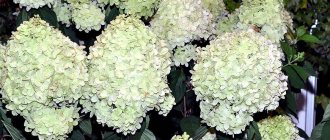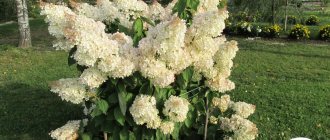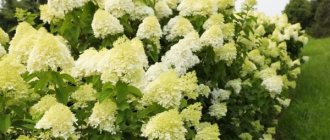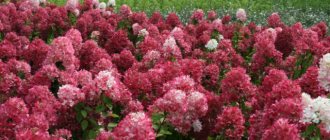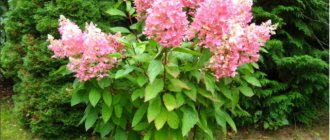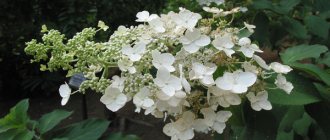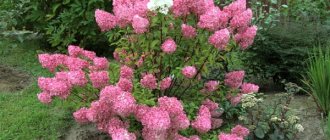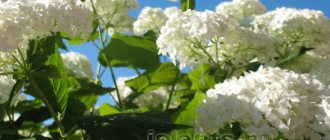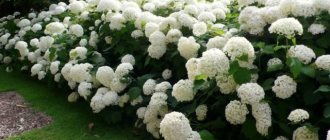History of selection
Hydrangea paniculata “Pinky Winky” is one of the most popular varieties among gardeners. It is part of the large Hydrangeaceae family. In the wild it is found in Japan and China, the Far East, South and North America.
"Pinky Winky" is characterized by its abundant, continuous and long-lasting flowering
The Pinky Winky variety is relatively young. Its breeding is the merit of Belgian breeders. It appeared in 2003. The main distinguishing features are the splendor and size of the inflorescences, which can change colors throughout the season. The Pinky Winky hydrangeas are based on Pink Diamond, another variety of the plant.
Growing conditions
There are nuances in growing Pinky Winky that a novice gardener should know about in advance, although at first glance everything seems quite standard.
Selecting a location
Hydrangea Pinky Winky has a well-developed root system that lies close to the soil surface. This means that when choosing a site for a flower, you should immediately select a permanent place, since it will not tolerate frequent transplants.
In heavily shaded flower beds, Pinky Winky blooms weakly, and the petals of its buds become pale. At the same time, the scorching sun can cause burns on the leaves. Therefore, you need to choose places with shading, but well-lit for half the day.
The growth of hydrangeas is negatively affected by proximity to plants that have a shallow root system, since the bush will not have enough nutrients for nutrition. It is worth paying close attention to the choice of Pinky Winky’s “neighbors”.
You also need to take into account that these plants do not take root well in areas where groundwater flows close.
Important! To prevent paniculate inflorescences from getting sick from exposure to drafts, you need to select a place that is not windy.
Climatic conditions
Pinky Winky feels good in any climate conditions
Pinky Winky does well in any climate. It blooms beautifully in the Ural mountains, in the Leningrad region, and even in the Far East. But amateur gardeners in the southern part of Russia will be especially pleased with the lush and long flowering, since there are more warm days here.
The soil
Hydrangea is picky about soil quality. It needs loose and light soils. Only acidic soils with a pH level of 4.5-5.5 are suitable; alkaline and neutral Pinky Winky soil is not recommended. But if there is no other option, then it can be flavored with peat or a special product (for example, acid+).
Plants prefer only fertile soil, so it needs to be constantly fertilized. Experienced gardeners recommend periodically applying organic fertilizers.
Description of the variety and characteristics
Botanical name: Hydrangea paniculata Pinky Winky. Paniculata hydrangea "Pinky Winky" is a perennial, beautifully flowering, deciduous shrub with a compact size. Its crown is dense, rounded, the branches do not deviate far from the center. Thanks to this quality, the plant looks good in any landscape composition.
The leaves are large, pubescent at the top, have an elliptical shape, and a pointed apex. The crown is painted in emerald green tones. In fall, the foliage turns beautiful red and orange colors.
The average height of the bushes is 2 m. Moreover, they grow quickly. During one growing season they can add about 30 cm. The diameter of the bush reaches 2 m. It has several central shoots. The tree-like branches of "Pinky Winky" point upward. They are so elastic and powerful that they can easily withstand the weight of voluminous inflorescences. The bush does not require additional supports.
Comment! Hydrangea "Pinky Winky" can be formed into a small tree. Standard hydrangea has a height of 1.5-2 m.
The root system of shrubs is very branched, but is located superficially. For this reason, plants need regular and frequent moisture.
Hydrangea needs frequent and regular watering
Hydrangea blooms for a long time. The panicle inflorescences are lush, voluminous, cone-shaped. They are often compared to ice cream in a waffle cone. The size can reach 30 cm in length. The first inflorescences appear on the bush in June. Their formation is completed in September and October, shortly before the onset of frost. They consist of small sterile flowers, the size of which is 3 cm.
Read more How to properly prune tree hydrangea in the fall
Over the summer, the color of the Pinky Winky hydrangea changes several times. During the summer, it gradually changes from snow-white or beige to pinkish, and then to soft light green. Often all possible shades are combined on one inflorescence: white on top, soft pink in the center, crimson at the bottom. It looks very impressive.
In comparison with some varieties of paniculate and tree hydrangeas, which can withstand temperatures down to -35 ° C, “Pinky Winky” is not so frost-resistant. But it tolerates cold temperatures of about -25 °C well without shelter, and can winter in such conditions without loss. Thanks to this quality, the plant is often grown in central Russia.
If temperatures in the region during the cold season drop below –30 °C, the hydrangea should be covered. For this you can use agrofibre or burlap. Additionally, it is worth mulching the roots with leaves and needles.
Comment! The older the plant, the better it tolerates wintering. It is recommended to insulate young hydrangeas in advance; low temperatures can be destructive for them.
Densely covered with inflorescences, the bushes look good against the backdrop of green lawns, along garden paths, near ponds or buildings. Hydrangea "Pinky Winky" is planted both in the garden and in flower beds, both singly and as part of group plantings.
Comment! Dry panicle inflorescences do not need to be cut off in the fall. With the onset of frost, they give bare hydrangea bushes a decorative appearance.
Landing
Pinky Winky hydrangeas can grow to their full size if you first select a location in the garden that meets the plant's requirements and plant accordingly.
Site selection and soil preparation
The ideal location for Pinky Winky hydrangea is sunny or partially shaded areas. This variety is the most sun tolerant and wilting resistant. In cool climates, full light during the day is recommended for better stem strength and long lasting colorful blooms. In partial shade it does not bloom so profusely. The soil should be well-drained, moderately fertile and rich in humus, slightly acidic (pH 5.5).
Learn how to acidify soil for hydrangeas.
The variety adapts to most soils, except very wet ones with stagnant water or excessively alkaline ones, and the color of the petals does not depend on the chemical composition and pH of the soil. If the flowers turn brown and dry instead of growing to pink or red, this indicates that the plant needs more water or night temperatures are too high to change to another color.
Landing dates
Hydrangeas can be planted in the spring, when the threat of spring frosts has passed, or in early autumn, so that the seedlings have time to take root before the onset of the cold period. Specimens planted in spring require abundant watering.
Step-by-step instruction
Before planting hydrangea, it is necessary to prepare the soil substrate for filling the planting hole. In the case of sandy soil, adding peat or compost to the garden soil will better retain moisture, and the clay composition will provide more effective drainage. A seedling planted in well-fertilized soil will not need other fertilizers for normal development throughout the year.
We advise you to find out why hydrangea leaves curl.
When planning to plant new hydrangea bushes, you should take into account all the requirements of this crop and carry out the procedure according to the proposed instructions:
- Dig a planting hole wider and deeper than the corresponding volume of the container in which the hydrangea was grown in the nursery (the larger its size, the more mature the plant). Make the walls of the hole vertical, and loosen the soil at the bottom by 10–15 cm.
- Before planting, soak the root ball in water for several hours to safely remove the seedling from the planting container. Heavily compacted roots must be carefully loosened by hand, and long and damaged roots must be cut off. This leads to further strong root growth, and the planted hydrangeas develop better.
- Place the bush in the center of the hole and fill it with soil.
- The planting depth is the same as the position of the seedling in the container. The main guideline is that the root collar should be 3–5 cm above ground level.
- Compact the soil well to ensure better contact of the root ends with the soil and remove air pockets.
- Form a small bowl-shaped area near the root zone, lining the edges with an earthen edge.
- Water the seedling thoroughly and add soil if necessary if the soil has shrunk.
- Mulching the planting site with bark will help maintain the required soil moisture and temperature, increase its fertility, which will have a beneficial effect on flowering, and slow down the growth of weeds.
- When planting multiple Pinky Winky seedlings, maintain a spacing of 1.8–2.5 m between individually growing plants. If you decide to grow them as a hedge, you can plant them 1.5–1.8 m apart to allow root growth systems have room to grow.
Reproduction methods
Propagation of paniculate hydrangea Pinky Winky is a troublesome and time-consuming task. For this reason, beginners in gardening should purchase seedlings in stores and garden centers. But if you can’t find the variety you like on sale, you can try to grow the shrub on your own by resorting to one of the propagation methods:
- seeds;
- cuttings.
The seed method is used extremely rarely. It will take a long time to get a blooming hydrangea with its help. In addition, the varietal characteristics of the mother plant are often lost.
Important! Natural varieties of hydrangeas are most often propagated by seeds.
Seeds are germinated in containers starting in February. The soil is regularly moistened. Then the seedlings are transplanted into a greenhouse and kept in it for two years, until the size of the bushes reaches 30 cm. Then the Pinky Winky hydrangeas are transferred to a permanent place, in open ground.
Read more How to properly care for and prepare hydrangeas for winter in the fall
A simpler and faster method is propagation by cuttings. It’s easy to get new plants with it. To do this you need:
- Cut the shoots in early June, when buds form.
- Put them in water.
- Divide each into several cuttings with 3 pairs of leaves.
- Remove the lower leaf blades.
- Place in a solution with a growth stimulator for 2 hours.
- Root the cuttings in open ground, covering them with film.
- Ventilate regularly.
- Completely remove the cover after a month.
Video on how to plant Pinky Winky hydrangea seedlings:
Seedlings grown by cuttings are transferred to a new location when they reach 30 cm in height.
Propagation of Pinky Winky hydrangea
Hydrangea Paniculata Pastelgreen
Before planting, it is also worth deciding directly on the type of propagation of the future hydrangea bush. Modern summer residents tend to adhere to two main types of propagation: seed and cuttings.
Reproduction of Pinky Winky
The seed type is considered to be more professional: it is more likely to be followed not by amateur summer residents, but by experienced flower growers and breeders. Propagation of hydrangea by cuttings is a less labor-intensive process.
Cuttings
First, it is worth collecting planting material, which can be obtained, for example, from neighbors when pruning the plant in the summer when the inflorescences are forming. Afterwards, from the removed shoots you need to prepare pieces with several (preferably two) nodes, then deepen the plant into a container with the mixture two to three centimeters and water it. When the shoots take root, the hydrangea needs to be transplanted into open ground in the garden.
Healthy. Propagation by seeds is used extremely rarely, even for production purposes. This method is labor-intensive, the result is not always pleasing, since from the seedlings a flowering shrub will appear after 2-3 years.
By layering
In early spring, the soil around the bush is dug up, fertilized and watered. After this, the shoot is bent to the ground and “pinned”. You can immediately sprinkle it with earth, you can do this after a few days. By the end of August, young shoots will appear from the rooting site. Closer to October, each shoot is separated and buried in soil.
Growing and care
Garden hydrangea "Pinky Winky" can be grown in temperate climates. She is photophilous, does not feel well in the shade, becomes pale and weak. Requires loose, fertile, acidic soils. For planting, it is worth setting aside well-lit or semi-shaded areas of the garden, protected from the winds, where the scorching rays of the sun do not penetrate during the midday hours.
If "Pinky Winky" is planted in a drafty area, it will look untidy
Planting and caring for hydrangea involves loosening the soil, watering and fertilizing, and pruning. The Pinky Winky variety is moisture-loving. In order for the plant to develop normally, it must be watered weekly, and in hot weather - twice a week. The soil should always remain slightly moist. Drought threatens hydrangeas with death.
Fertilizing ensures flowering. The soil in the area where Pinky Winky grows must be fertilized at intervals of 2 weeks. For the first time this season - after the leaves bloom. It is recommended to use nitrogen compounds that ensure the growth of green mass. When the buds form, the hydrangea is fed with fertilizers, which are dominated by potassium and phosphorus.
Care
For hydrangeas to be healthy and beautiful, they need care, which consists of the basic rules of cultivation.
Watering and fertilizing
During the first year after planting, regular watering of hydrangeas is required until they take root and become stronger. Once Pinky Winky bushes are established and well developed, they are more drought tolerant than some other hydrangea varieties. When watering, make sure the ground under the mulch and surface soil is deeply moist. It is better to water deeply several times a week rather than in small doses every day.
Important! Do not use fertilizers with a high nitrogen content, as this leads to rapid growth of green mass to the detriment of flowering.
If water does not penetrate into the lower layers of soil, the roots will develop closer to the surface and the plant will not be drought tolerant due to the lack of a deep root system. It should also be taken into account when watering that the roots of hydrangea lie shallow, and the border of their distribution significantly exceeds the diameter of the crown of the bush. On very hot days, hydrangea leaves and flowers may wilt, so watering is necessary.
Otherwise, wilted and underdeveloped inflorescences will not be able to restore their appearance until the end of the season. To fertilize bushes, you can use well-ripened compost or manure, as well as multicomponent mineral compounds, but with a low calcium content. The best way to feed hydrangeas is to apply a slow-release fertilizer for shrubs and trees in early spring, shortly after the bushes are pruned.
You should choose fertilizers that do not contain lime and are specially designed for paniculate hydrangea - Biopon, Compo, Planton H, Agrecol, Lauren. Fertilizing is carried out during the growing season with frequency in accordance with the recommendations of the manufacturers of the selected fertilizers. Feeding is only necessary during plant growth and should be stopped in early August. After this period, hydrangeas enter a dormant phase and begin to form flowering shoots for the next season.
Trimming and shaping
The best time to prune Pinky Winky hydrangeas is early spring, which helps to increase the size of the flowers, shape the crown and makes it possible to sanitize the bush. Larger flower panicles can be achieved by thinning plants to 5–10 primary branches.
This variety blooms on new growth of the current season, so there is no risk of removing potential color. The bushes can be pruned to 60 cm in height, due to which the trunk will thicken at the bottom and the crown will take on a lush shape. Elongated branches are shortened to the first set of buds. In subsequent years, the hydrangea is pruned higher, following the principle of the number of inflorescences left.
Shelter for the winter
Pinky Winky is one of the best and hardiest hydrangea varieties that can easily survive the winter seasons. As soon as the temperature drops, the leaves and inflorescences turn brown. No special winter cover is required, just make sure there is a sufficient (15–20 cm) layer of dry leaf or bark mulch on the soil around the root zone to protect the roots from freezing.
Vegetative dormancy lasts from November to March. Because this variety of hydrangea blooms on new wood, even if it freezes to the ground, new growth will spring up when spring arrives, ensuring the plant's survival.
Only young, fragile bushes need to be covered for the winter with agrotextiles, spruce branches or straw mats. If you purchased container seedlings in the fall, store the hydrangea in a cool place over the winter and keep the soil slightly moist until you can plant the plant in the garden in the spring.
Video: preparing paniculate hydrangea for winter
Pruning and preparation for winter
The Pinky Winky variety is pruned in the same way as other paniculate hydrangeas. This is done for sanitary purposes in the spring. The shrub is freed from dried, damaged, diseased shoots. And healthy ones are shortened by 2 pairs of buds or more. The shorter the branches are, the larger the diameter of the inflorescences that bloom on them will be. No pruning required in autumn.
Hydrangea "Pinky Winky" is a frost-resistant variety. Mature shrubs are not covered for the winter. And young ones can die from the cold, so shelters are prepared for them. The soil is mulched with manure, peat and dry leaves. The layer thickness should be 20 cm.
More details Hydrangea paniculata Vanille Fraise (Vanilla Fraise): description, how to prune, reviews
Features of care
The Diamant variety does not require special care. It is enough to know the basic rules for handling hydrangea, then it will grow well.
In order for hydrangeas to bloom magnificently, they require at least minimal care.
Shrub pruning
Hydrangea Pink Diamond, like any other plant, needs timely pruning. This not only gives the bush an aesthetic appearance, but also allows it to grow even more luxuriantly.
The main pruning occurs in the spring. Removed:
- dead shoots;
- damaged branches;
- strongly protruding shoots.
For your information! It is necessary to thin out the crown from time to time. The procedure is carried out in the fall.
Watering
Diamond needs abundant watering during growth. Therefore, in the early stages it is necessary to water frequently to prevent possible drying out.
Following simple rules, the bush will bloom and smell. Necessary:
- in case of frequent rains, water once a month with a couple of buckets of water;
- in case of rare rains, water 2-3 buckets every week;
- in dry weather, water 2 times a week.
Watering should be done carefully, as excessive amounts of moisture harm the plant.
Feeding and fertilizer
An important step in caring for this hydrangea variety is the application of fertilizing. As with watering, you need to actively feed in the spring. Organic matter and mineral additives are used as fertilizers. Feeding can be divided into three stages:
- in spring, use saltpeter, peat or chicken droppings;
- in summer - potash and phosphorus fertilizers;
- In the fall, stop fertilizing to prepare for winter.
Note! You can get rid of yellow leaves with lemon juice or iron sulfate diluted in water. Diamond is also fed fermented milk products
Pink Diamond in winter
Hydrangea is resistant to cold weather. If in winter the temperature does not drop below −15 °C, then the bush does not need to be covered. Frozen shoots will return to normal in the spring. However, in extreme cold, Diamond needs insulation. This is especially true for young seedlings.
Before the cold weather, you need to carefully lower the branches down and sprinkle them with leaves. Cover the ground around the plant with film. The top of the hydrangea is sprinkled with peat, and the top layer is covered with slate. This will allow the shrub to survive winter down to −30 °C.
Pests and diseases
According to gardeners, Pinky Winky hydrangea demonstrates resistance to most diseases and pests. But if not properly cared for, plants can infect:
- Powdery mildew. To combat it, fungicides or copper sulfate are used.
- Chlorosis, which manifests itself as a change in leaf color. The remedy against the disease is potassium nitrate.
- Aphid. Get rid of the pest with soap solution or insecticides.
Diseases and pests
| Problem | Symptoms | Prevention | Treatment |
| Chlorosis | Deformed buds, yellowing of leaves, curled edges of leaf blades, shallowing of foliage. | Fertilize in a timely manner with organic matter and mineral complexes (universal preparations such as Florist Micro, Uniflor Micro, Kemira Lux are also suitable), and disinfected tools are used for pruning. | At initial signs, spray with Iron Chelate. The use of Agrecol, Ferrilene, Ferovit is also allowed. In case of extensive damage, the funds are applied at the root. As an alternative, use a solution of potassium nitrate, which is poured onto the substrate 2-3 times. |
| Powdery mildew | The first manifestations are small spots on the outside of the leaf, gradually increasing in size. As the disease progresses, yellowing of the leaf blades, the appearance of necrotic spots, and early loss of foliage are observed. | They weed in a timely manner, remove plant debris, avoid crowding of plantings and thickening of the crown, as well as an overdose of nitrogen compounds. | Traditional methods: whey, ash, iodine, mouth rinse. Purchased drugs: Agromedicine, Vectra, Topaz, Alirin, Chistoflor. |
| Gray rot | A grayish dusty coating first appears on young shoots. Leaf blades lose elasticity and change color. | They adhere to the norms of the watering regime; excessive soil moisture in cloudy weather is not permissible. Regularly loosen the soil and maintain the recommended distance between plants. | Treat with a solution prepared from 10 liters of water, 200 g of ash, 200 g of chalk and 1 tsp. copper sulfate (enough for 3 sq.m.) |
| Root rot | The stem darkens and the plant quickly fades. | They do not allow stagnation of moisture, disinfect the substrate before planting, remove weeds after weeding, and apply foliar feeding. | Purchased products: Trichodermin, Trichofit, Fundazol, Topaz, copper sulfate, Gliokladin, Maxim, Vitaros. |
| Aphid | Tissues are deformed in places of massive punctures, leaves curl, inflorescences fall off, and growth stops. | They eliminate anthills, attract birds to the site, and regularly weed the flower beds. | Sprayed during the growing season and at the first signs with systemic drugs: Floristin, Tsvetolyuks, Calypso, Tanrek. Folk remedies: infusion based on tobacco or hot pepper. |
| Spider mite | Pale thin cobwebs, dry leaves, light blotches on the surface | Maintain order on the site by promptly disposing of plant debris. Spray with garlic infusion (2 crushed heads per 1 liter of liquid, leave for 5 days). | Iskra-Bio, Bitoxibacillin, Kleschevit, Tiovit-Jet, Fufanon-Nova. |
Application in landscape design
Pinky Winky hydrangeas make a wonderful addition to the garden all year round, from spring to winter. They are planted separately or in groups, used to create hedges, and kept in large containers for decorating terraces. The culture creates an interesting combination with barberry and other shrubs.
The hydrangea variety “Pinky Winky” is grown on a trunk. It is notable for being suitable for forming low trees. To do this, the central shoot of the hydrangea is left, and the side shoots are pinched several times a season.
In the shade, shrubs lose their decorative effect
How to care for Pinky Winky
If you carefully read the cultivation rules, caring for Pinky Winky hydrangea will not be difficult.
Watering and mulching
Pinky hydrangea is responsive to watering, but at the same time it absolutely cannot tolerate stagnant moisture and soil compaction in the tree trunk. It is inappropriate to give any specific recommendations regarding the frequency and intensity of watering in this case. It all depends on the climatic conditions of the region.
- In regions with a dry, hot climate and drying winds, with a long absence of precipitation, young plants are watered every other day.
- In areas with a humid climate, the frequency of watering is reduced by 2 or even 3 times.
Important! The Far East is considered to be the historical homeland of paniculate hydrangeas. Therefore, all plants in this group “love” cool, moist soil
To reduce soil temperatures in the root system zone, mulch it with a thick layer of bark, leaf litter or pine needles. For the same purpose, ground cover plants are planted near the hydrangea.
Top dressing
Hydrangea is very demanding when it comes to applying organic and mineral fertilizers. To achieve abundant and colorful flowering, from early spring until the formation of buds, it must be fertilized every three weeks with a solution of mullein: infuse 3 kg of manure in 10 liters of water, and then use 1 liter of slurry per bucket of water.
An analogue of repeated fertilizing can be a one-time application of granular complex fertilizers in early spring. These include:
- Osmocote.
- Greenwold.
- Pokon.
- Kemira is an all-rounder.
During the period of budding and flowering, hydrangea needs potassium-phosphorus fertilizers:
- monopotassium phosphate;
- superphosphate;
- complex fertilizers for flowering shrubs.
Important! Starting from the second half of summer, it is strictly contraindicated to apply fertilizers containing nitrogen. It provokes an abundant growth of leaf mass and young shoots that do not have time to ripen by the end of the summer season
In addition to macroelements (NPK), the plant needs a portion of microelements (iron, fluorine, calcium, boron, manganese). They can be applied either at the root or along the leaf (by spraying).
Trimming
The first pruning is done in early spring, before the sap begins to flow. At this time, all frozen and weak branches are removed, all last year's shoots are shortened by 2/3 of the growth. This action provokes increased branching and abundant flowering (a flower is laid on each shoot). Also remove all excess shoots growing inside the bush or crossing each other.
Bush after pruning in autumn
In the fall, faded brushes are cut off to prevent the branches from breaking off under the weight of the snow cover, and sanitary pruning is carried out. Excess branches are not removed, since it is impossible to predict in advance how the plant will survive the winter cold.
Pruning is done with a well-disinfected tool.
Planting process
The recommended time for planting hydrangeas is early spring, although the shrub can also be planted in the fall. Spring planting allows the plant to take root well and gain strength over the summer. When planting in autumn, according to experienced gardeners, the survival rate of hydrangea is much worse.
- The seedling is placed in a prepared planting hole and covered with prepared soil mixture;
- The root collar should be at soil level;
- The earth is compacted by hand;
- The tree trunk circle is watered abundantly;
- The soil around the seedling must be mulched;
- Regular watering is carried out for several days for better survival of the seedling.
Use Cases
Pinky Winky is an ideal solution for landscaping parks, squares, gardens, and personal plots. Flowering shrubs enliven the recreation area, give it unique features, and make the yard cozy. The variety is often used in landscape design as an accent plant. It is suitable for placement near the gazebo to form a hedge. The flower can be planted on the shore of a decorative pond.
The shrub is good in group compositions, especially if it is accompanied by other types of paniculate hydrangea with contrasting colors of inflorescences or herbaceous and decorative leaf crops of smaller sizes, providing a tiered effect in garden ensembles. This way Pinky Winky will stand out among his peers. A good option is to plant ornamental shrubs in splendid isolation. It looks especially advantageous against the backdrop of a green lawn. You will never get tired of admiring it!
Planting hydrangea: recommended soil
If you have chosen this shrub for your yard, then it is worth considering that caring for it must be constant, and this is a troublesome task. This is a light-loving plant that should grow only in a well-lit area, protected from drafts. Light partial shade will not frighten him, but a sunny meadow will be better.
It is advisable to take care of fertilizing the soil in advance, since the plant will grow and develop only in well-fertilized soil with an acidic reaction. The area for planting the bush needs to be dug up so that the soil is loose. Lime in the soil can be detrimental to the plant - this must be taken into account.
Working with the place where the hydrangea will grow
To plant a bush, you need to dig a hole no more than 50 cm deep. But this will directly depend on the size of the root system of the material that you bought for planting. You need to pour a nutrient substrate into the hole, which is prepared in advance. To prepare it you need to take in equal proportions:
- humus;
- leaf soil;
- sand;
- peat.
To acidify the substrate, you need to add soil that is intended for coniferous plants.
A seedling is planted in a prepared, fertilized hole, and then watered abundantly with water.
If you want to buy a seedling with an open root system, then you need to do this in early spring, and you need to replant such seedlings only in early spring, from April to May.
Description
The hydrangea family is named after the sister of the prince of the Roman Empire - Hortensia. The number of hydrangea genus is more than 80 subspecies.
Pinky Winky is a medium-sized tree or shrub with a spreading crown. The plant reaches a height of 2 meters.
This unusual, beautiful bush is considered perennial; its stem is quite elastic and powerful. Hydrangea leaves have an oblong shape, the edges are formed in the form of teeth. The leaf color is dark green. The leaves are a little rough to the touch.
The inflorescences of the plant are formed in a cone-shaped form. White flowers at the edges of the branch are collected in a paniculate form. A characteristic feature of Pinky Winky is that the color of the flowers and their saturation can vary from white to soft pink. The inflorescences take a long time to acquire color, and it changes unevenly.
The flowering period of Pinky Winky is from July to September.
The bush is not too demanding regarding lighting, so it can grow even in partial shade.
To ensure acceptable growing conditions, it is important to control soil moisture. Hydrangeas need to be watered once a week, and the soil should be loosened - 2 times a season.
In order for this type of hydrangea to please the eye with its rich flowering, the shoots of the bush need to be pruned by 2/3 annually.
For maximum comfort, Pinky Winky needs moderate climatic conditions, but the shrub can also withstand severe frosts. The plant does not require shelter during the cold season, as it thrives at temperatures down to minus 30°C. If the bush is still young, you will have to take care of it during the cold season. To do this, it will be enough to cover the soil with dead wood and the plant itself with thick burlap.
Planting in open ground
Hydrangea Pinky Winky, like any other plant, requires careful preparation during the planting process. It is better that hydrangeas are planted in early spring.
When planting a shrub in the ground, the seedling is placed in a well-moistened hole (depth less than 50 cm), the bottom of which was previously covered with a mixture of peat, sand, humus and fallen pine needles.
In order for the plant to take root well in a new place, it is necessary to fertilize the soil and soil. For these purposes, it is appropriate to use a mixture of sand, peat, pine litter and humus, which is placed on the bottom. You can also use mineral fertilizers by pouring them into the hole. In this case, the neck of the root should remain above the ground.
Until the plant finally takes root, it needs to be watered regularly.
Preparing the site and soil
In order to plant Pinky Winky hydrangea according to all the rules, you need to make a hole in the ground measuring 50 cm. Humus, rotted leaves and pine needles, sand and peat in equal proportions are placed at the bottom of the hole. Then the seedling is placed in a hole with fertilizer, covered with soil and watered.
To prevent hydrangea from experiencing moisture deficiency in the summer, it is recommended to cover the soil around the bush with dry grass or sawdust.
You can feed the plant with saltpeter twice a year.
How and when to plant?
According to the recommendations of experienced gardeners, it is best to plant Pinky Winky in the ground in early spring. This is due to the fact that it is at the beginning of spring that sap flow in the bush has not yet begun.
Indeed, this period for planting shrubs is optimal, because the plant has enough time to take root well before the summer heat and gain strength before the harsh winter cold.
How to grow hydrangea?
The better all the conditions are met, the less attention the plant requires in the future. The abundance and duration of flowering, as well as the ability to survive frosts, depend on the soil, lighting and ambient temperature.
When planning to grow hydrangea paniculata of the Pinky Winky variety on your site, you need to carefully not only choose a place, but also prepare it.
Landing
Preparing a site for Pinky Winky hydrangea
First you need to pay attention to the lighting of the area. Light should be moderate, without prolonged exposure to active sunlight. You can choose a place with partial shade, but no more than half the daylight hours. It is better if this time falls during the midday sun, which can leave burns on the surface of the leaves.
Important! It is also necessary to take into account that a stable lack of sunlight will lead to a decrease in the number of buds and the splendor of inflorescences. The same factor affects the duration of flowering. It is ideal to plant hydrangea where there will be shade at midday.
Planting Pinky Winky hydrangea can be done near tall trees, buildings or fences. When determining a location, it is necessary to study the composition of the soil. For this variety of plants, it is preferable to choose soil with a neutral, slightly acidic and acidic reaction.
It is advisable to avoid alkaline soil with a high percentage of clay. Pinky Winky responds well to high humidity, but when choosing a location, you should exclude areas with groundwater, this can lead to root rot, especially if there is no high-quality drainage layer.

